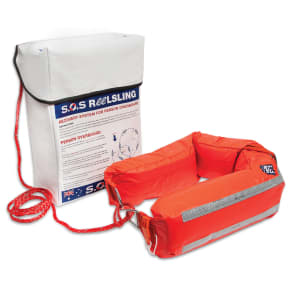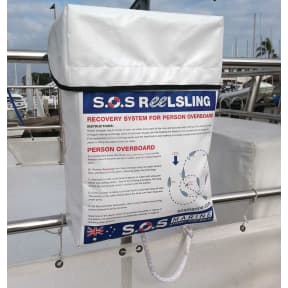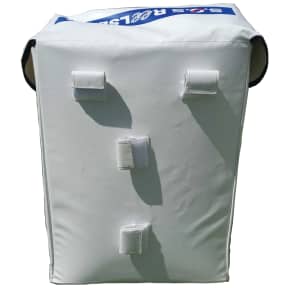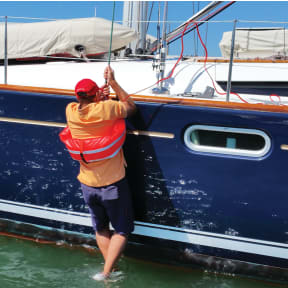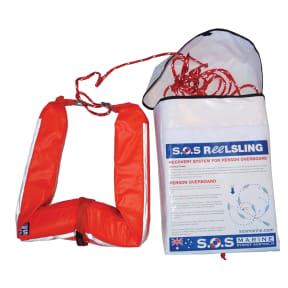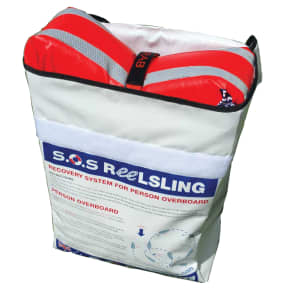





Description
The Reelsling man overboard recovery device helps you get a conscious overboard crew easily back onboard.
It features 21 pounds of buoyancy, has generous light reflective tape, a sturdy grab handle, stainless steel D-rings for hoisting, and a whistle. It doubles as lifting harness for getting the victim out of the water and back onboard.
The Reelsling is tethered to the boat with 164 ft (50 m) of floating retrieval line which does not absorb water and has an ingenious reflective tracer strand. The Reelsling is easy to see, easy to hear, easy to stow, and easy to use.
The Reelsling deploys from a durable, UV resistant, easily cleaned PVC bag - with Velcro® tabs on the back for securing to the rail for quick access.
Instructions are printed on the outside of the bag so, in heat of the moment, everything you need to do is spelled out.
The Reelsling makes quick, easy, economical work of man overboard recovery.
The Reelsling can be used as the middle step in a complete 3-step Man Overboard Recovery System consisting of the Dan Buoy location marker, the Reelsling retrieval device, then followed by using the Recovery Ladder for final re-boarding of your crew member. See Related Products, below.
• Red, easy to see float
• Generous 164 ft of floating, reflective tether/retrieval line
• Large reflective surfaces on the float make it easy to see in darkness
• All sunlight exposed components are UV resistant for long-lasting durability
• Replacement stowage bag available
Heavy on the technical side...
Using the Reelsling...
When you mount Reelsling outside on your vessel, tie the line’s bitter end to a strong point. The bitter end is sheathed with UV-resistant rope as it remains exposed to the elements. The Reelsling stays stowed in its bag until needed.
In the event of a man overboard emergency, the first thing to do is mark the location by throwing a Dan Buoy, MOB flag, or other marker in the water. This gives your MOB a highly visible, easily findable, reassuring float to hold on to and facilitates next steps in recovery. If you have a GPS unit, you should also immediately record the location with a waypoint, so you can return to it. With all that is going on, having an immediately accessible marker buoy mounted on deck is essential.
Next, pull the Reelsling float out of its mounting bag and throw it in the water. Pay out the tether line astern. Because the tether's bitter end is made fast to a strong point on your boat, you cannot pay out too much line. Keep enough way on to maintain steerage and avoid drifting backward over the deployed floating line and Reelsling float.
Turn the boat in a circle around the man overboard (MOB). Your marker buoy/flag will make his position easier to see in waves or darkness. Without a marker buoy the victim will be surprisingly difficult to locate. Make your circle about 100 to 150 feet in diameter. The tether line will draw toward the circle’s center as you complete your circle. When the line comes within reach of your MOB, he can grasp it. At that point, turn the vessel into the wind so the MOB can pull the Reelsling floatto himself - placing the Reelsling float over his head and under his arms. Drift downwind, back toward your MOB, while pulling the line in, keeping the line clear of rudder and prop.
Hoisting the MOB aboard
Getting your MOB back to the vessel is only part of the rescue process. In fact, getting the person back on board may prove to be the most difficult part of a rescue.
Ahead of the need, consider how you can employ a multi-part purchase for mechanical advantage in hoisting your crew aboard. You can tie a loop into the tether line for an instant attachment point for a halyard or block and tackle purchase.
On both a sailboat or a powerboat, a welcome alternative to lifting crew out of water with the Reelsling is to use the Recovery Ladder. It enables very quick exit from overboard for uninjured crew and avoids injury from conventional boarding ladder or swimstep crashing down on the crew member in a seaway.
